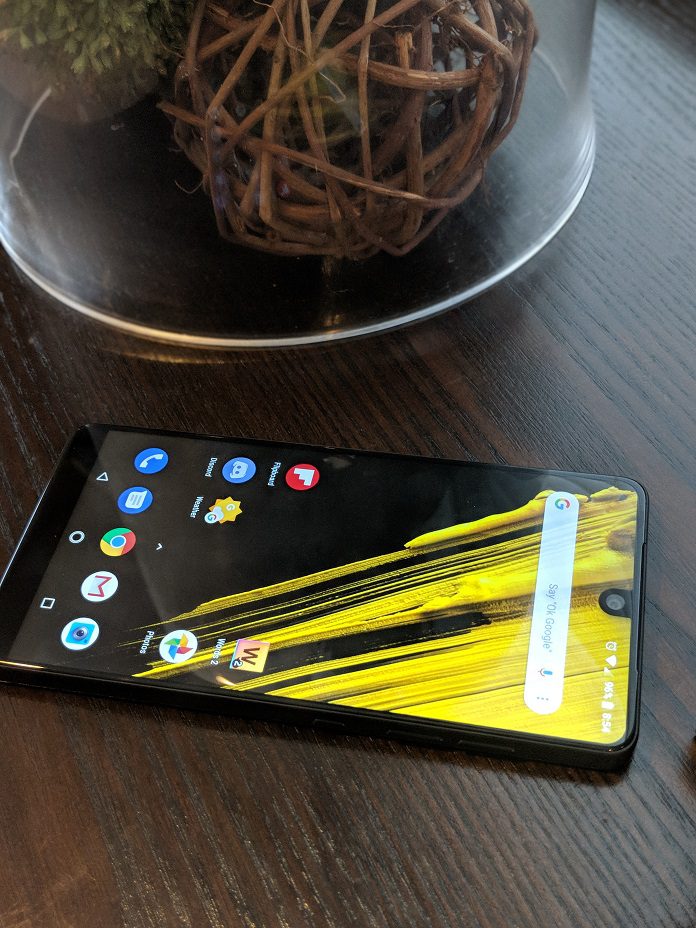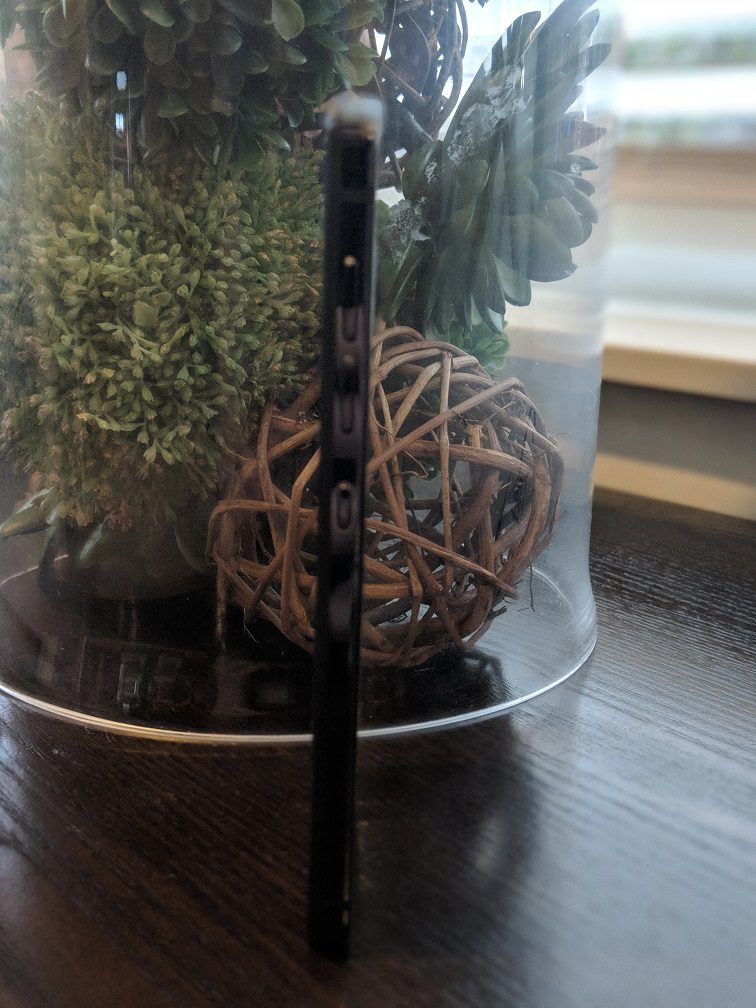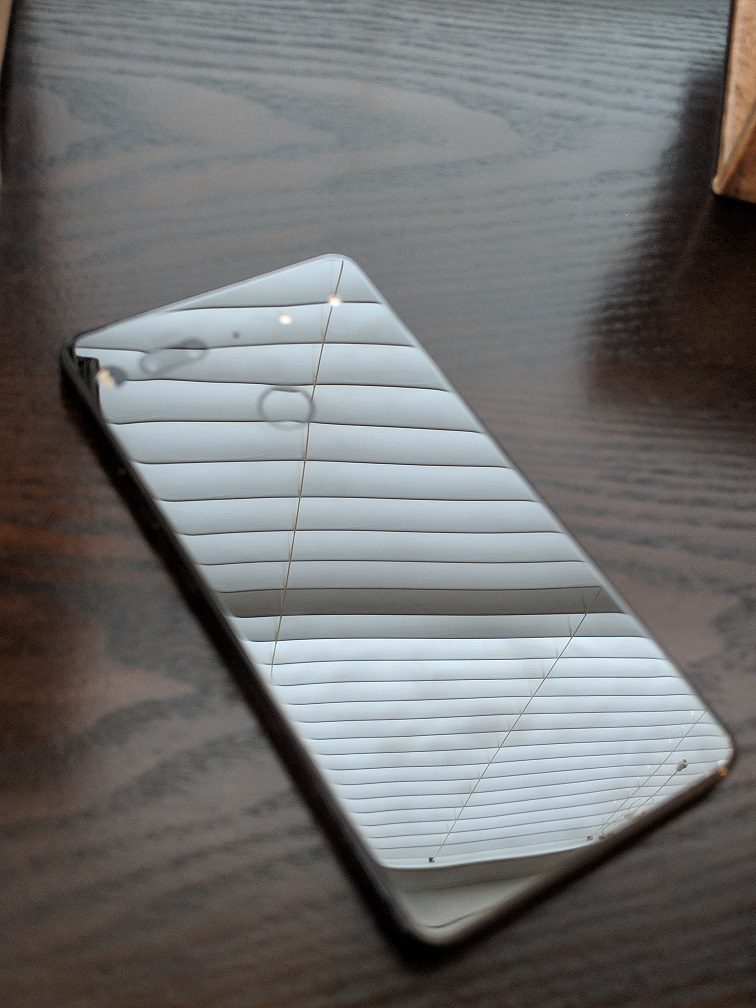The Essential Phone (model name: PH-1) is striking to behold. It’s titanium body adds a premium feel and weight to an otherwise familiar shape. That familiarity goes away when you power on the device and it becomes the cleanest Android experience available, along with a gorgeous display design that covers more of the front panel than any other phone, including the iPhone X. The phone has had a heck of a run. From reportedly low sales through last fall, to a recent resurgence after a well-timed price drop and new colors. At $450 the Essential Phone is one heck of a value and shouldn’t be overlooked.
Build Quality & Design
The titanium body and ceramic back of the Essential Phone gives it a premium and executive feel. Upon holding it, the weight, curved edges and overall thickness is that of quality. When the Essential Phone launched at $699, this feeling was an expectation. But at it’s current price of $449, it’s an added value. The overall dimensions are 5.5″ x 2.8″ x 0.3″ with a weight of 6.5 ounces. The weight of the larger Note 8 is 6.84 oz and the Pixel 2 XL weighs in at 6.1 oz.
There’s a reason titanium is used to build rockets and replace bones. Unlike aluminum, which most phones are made of, titanium is exceptionally more durable. Our phone housing can resist scratching, denting, and bending as it’s made from a harder, stronger, and more resilient material.
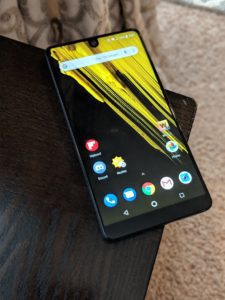
The display is what really drew me to the Essential Phone. The display covers 84.9% of the front of the phone. Other phones come close, such as the Galaxy Note 8 (83.2%) and Galaxy S8 (83.6%). While others are nowhere near it, such as my daily phone for the past 6 months, the Pixel 2 XL (67.9%). Coming from the Pixel 2 XL, the only thing I really miss is the OLED display. Colors really pop on the Pixel 2 XL, but after a few days with the Essential Phone, I forgot what I was missing. When I booted the Pixel 2 XL again so I could take comparative photos, I sat there wondering if I should switch back. But, overall, I prefer the minimalist design of the Essential Phone over any other phone I’ve used. The ceramic back, however, is a little too slick for me. More on that later.
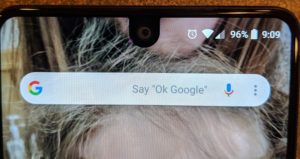
Minimalist notch. We’ll end up here after the iPhone X fad is over.
To achieve such a strong screen-to-body coverage, their is a notch. Nope. Apple is not the first manufacturer to have a notch. The Essential Phone’s notch is not as odd as the iPhone X’s. It’s a beautiful design and the implementation is flawless; using just enough space for camera. Some apps are well integrated into the space surrounding the notch, but many are cutoff below the camera. I do wish Essential had put physical OS navigation buttons on the “chin” of the phone where the bezel exists. That would have opened up the display to even more content. But in order to make Android navigable they’d have to get into customizations in the OS. The display is LCD instead of OLED, which is all the rage lately. OLED has a stronger color representation, so it can really make your photos pop. Videos look good but certainly not as good as with an OLED screen. Keep in mind the world’s most popular video game console, the Nintendo Switch, uses an LCD display. It’s not a bad thing and has many advantages. For example, LCD performs better with the brightness down and there is no burn-in risk.
If you like to use your phone for watching movies and playing music, note the Essential Phone has just 1 speaker. It’s on the bottom to the left of the USB-C port (primarily used for charging). To the right you’ll find the SIM card slot. That bottom is accented with a reflective, deep gray finish, which extends around the entire phone. The back of the phone is made of ceramic and is both reflective and smooth. There are 2 data magnets (I don’t know the formal term) on the back for mods. The only available mod is the 360 degree camera, which I do not have for testing.
User Experience
You won’t find a cleaner Android experience than the Essential Phone. That includes any of the Google phones available today. This is part of Essential’s core principals, which aligns well with my preferences. I moved on from Apple and Samsung phones for this reason. I’ve also moved on from carrier-locked phones for that reason as well. If you buy a phone from Verizon, for example, you’ll get their apps as well.
Owning a phone is the most personal tech experience we have. If you’re reading this, you need to understand my perspective and experience: my phone journey started with a standard Nokia flip. But when I joined the workforce I had a BlackBerry and then an iPhone. As I grew to appreciate the open nature of the Android UI experience, I journeyed from the Note 4 to the Nexus 5X. Since then I’ve always been in the Google family of phones. I’ve been willing to pay the extra dollar for their clean Android experience and quick updates (always buy unlocked phones!). I was thrilled to see just 20 pre-installed apps on the Essential Phone. The only app Essential puts on the phone that is outside the stock set is their camera app.
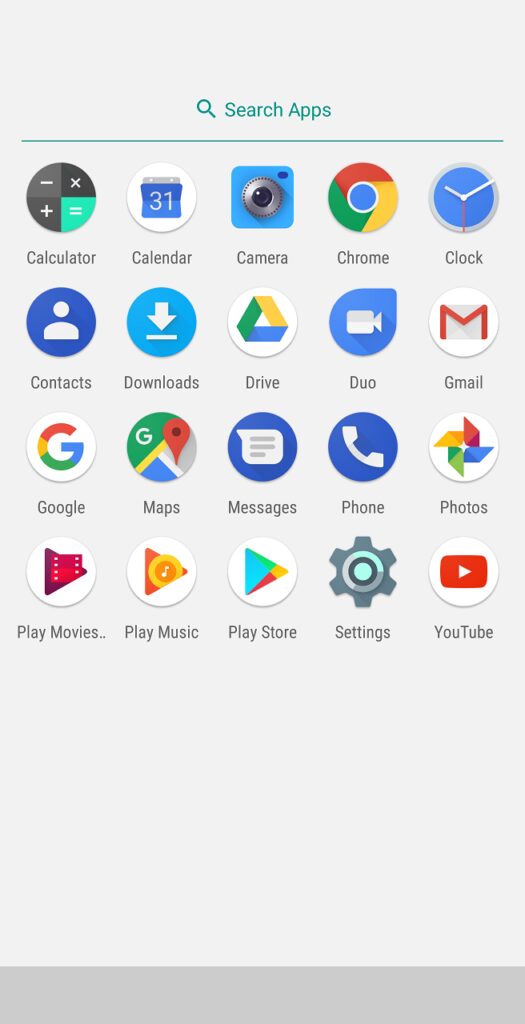
Love at first boot.
The photo quality on the camera is not great. But it’s not bad either. I’d put it somewhere in the middle. The rear cameras are a pair of 12 MP lenses that work well together, provided you have adequate lighting. The shutter speed and auto-focus are slower than I’d like. I’m coming from the Pixel 2 XL, which has the best camera of any phone. To help see the difference, I’ve uploaded two similar pictures from the Pixel 2 XL and the Essential Phone. You may not notice the difference if you don’t have the reference photo of the Pixel 2 XL. Had I came to the Essential Phone from the Pixel 1 (skipping the Pixel 2 XL) I would be happy with the photo quality.
Pixel 2 XL

Essential Phone
The file sizes were roughly 6:1. The Pixel 2 XL’s picture of my little dog, Sealy, is much more detailed. You can see it clearly in her fur as well as the surrounding carpet. That’s a let-down but one has to remember the Pixel 2 costs $400 more than the Essential Phone. I have a suspicion that side loading the official google camera app may help with the shutter speed, which would solve several issues.
Aside from the software experience, all of that build quality and design I’ve raved about has to be evaluated from the user perspective as well. The volume and power buttons are differentiated by their size. The power button is located below the volume buttons. The power button is about half the size of the volume buttons and all are located on the right side of the phone (just like the Pixel). There is a single-lens camera in the front, which does not support Portrait Mode (a let-down). The dual-lens cameras on the back do support auto HDR+, Portrait Mode and Slow-Mo. I’m a fan of the monochromatic camera as well. If you purchase the black Essential Phone, the ceramic back is reflective and can help you with those Portrait Mode selfies. This is not a feature – it’s a workaround. With that reflective screen comes a very slick surface. If you rest the phone on your lap and it’s not completely level, it’ll find a way to slide down. I suggest a skin for the back or that you purchase the new model that has a matte finish.
Essential added a subtle but awesome effect: a status light. It’s located above the display to the left of the camera. The colors vary and represent various notifications, from unread text messages to missed calls.
Android 8.1 is available for the Essential Phone. You won’t get Android updates as quickly with Essential as you would the Pixel phones, but I bet it’ll be the first non-Google phone to get these updates. Also, if you’re wondering, the turnaround for 8.1 wasn’t too long – although Essential worked on an unreleased build of Android 8.0 prior releasing 8.1. Also, other smartphone makers have been slower than Essential. Samsung’s support of Android on their S8 line of phones is likely going to suffer as they are already moving on to new phones (the S9). Samsung and other phone makers have a history of skinning Android to provide a differentiation. For example, Samsung’s Note series has a Samsung-developed split screen. This was around well before Google’s implementation. This can be a great thing, but dozens upon dozens (in the case of Samsung) of mods leads to a long stack of software that you may not need, want or even know about. Anyhow, Essential haven’t done that. This phone is clean.
The Essential Phone hasn’t slowed down or crashed at all.
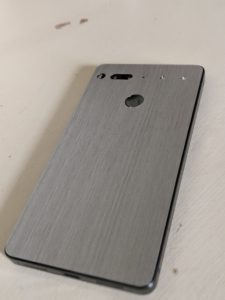
I used a dbrand skin to improve grip. Works like a charm.
Performance
The Essential Phone is packed with the fastest Snapdragon CPU from 2017 – the 835. This is the same CPU from every flagship available presently, save for the brand new Galaxy S9 and S9+. It also has 4GB of RAM and a 128GB SSD. There are no configuration choices aside from this one SKU. My experience has been excellent. The phone hasn’t ran slowly or crashed at all. Not once. Let me be clear: in 2 weeks, my launch unit Essential Phone, running Android 8.1, has never crashed. I’ve had 4 Pixel 2 XLs. My most recent unit has been the most stable but still has random issues after each update by Google. That’s not to say it’s a perfect phone. The Essential Phone has documented issues with Bluetooth stability. While in my car I had issues with the connection to my Tune2Air adapter, which is used for streaming media from my phone to my car. The connection to my Audi MMI system for phone calls was just fine, however.
Battery performance has been better than expected. The included 3040mAh battery last me a full work day before needing a little kick prior to the evening. With the Pixel 2 XL I used a combination of airplane mode and wi-fi calling to save battery life. Unfortunately, the Essential Phone does not natively support wi-fi calling. I was able to get text messaging to work but not phone calls. But even with this limitation, battery life was still very good. In fact, the latest issue with the Pixel 2 XL is battery drain and overheating. So, again, the Essential Phone is on top. The only issue is the camera hardware and/or the software. The shutter speed is slow – sometimes taking 2 or 3 seconds for the picture to be taken. This often yields a blurry, dark and grainy photo.
Who is this for?
I’m a believer in the Essential Phone.
At $449, the Essential Phone has the best value I’ve come across in modern phones. It would benefit from dual speakers, a standard matte finish and a better camera experience. Other areas of improvement are really user-preference, such as a headphone jack and an OLED screen. I use my phone a lot in dark settings, so the OLED of the Pixel 2 XL has been a drag due to ghosting issues. When it comes to the overall experience, however, the package of the Essential Phone both inside and out, is not complete but is exceptional. The last time I opened up a phone and felt impressed was my first iPhone (4). All of this praise and it’s Essential’s first phone! I’ll be in line for the Essential Phone 2 – no question.


